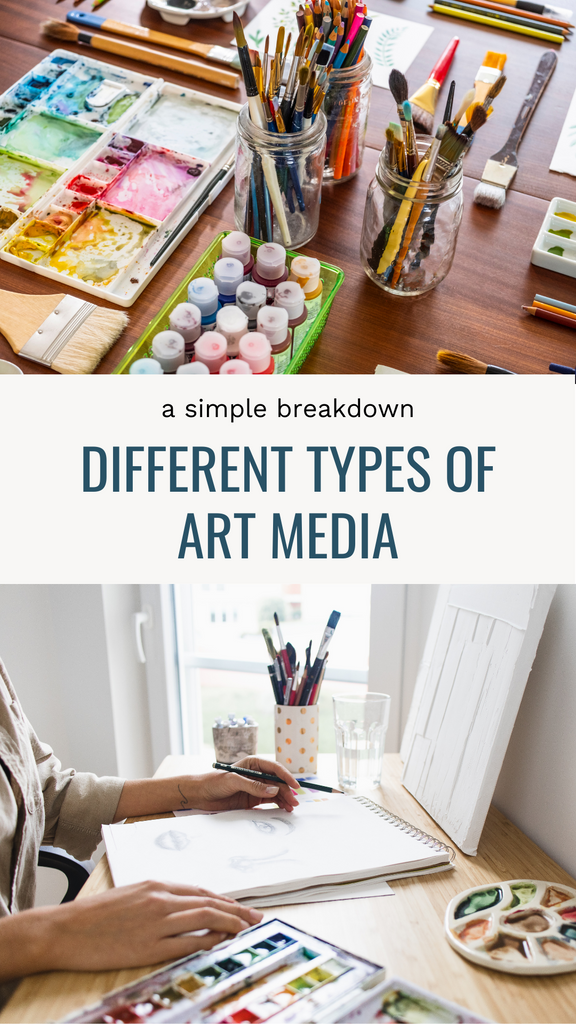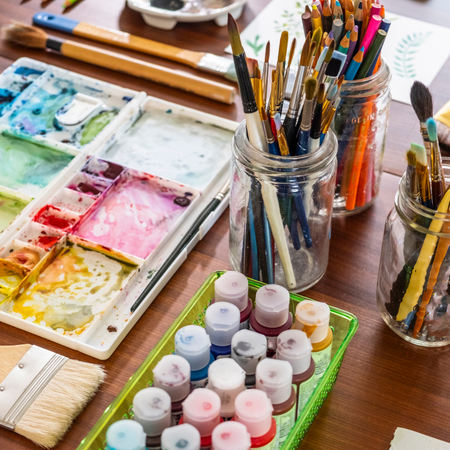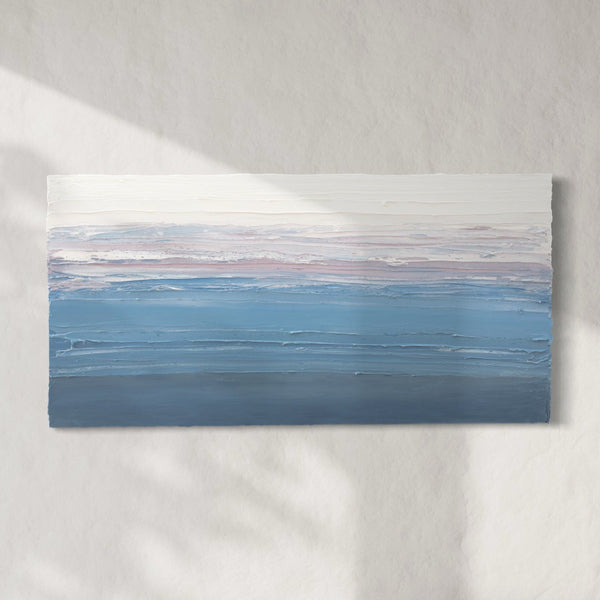At a time when many of us have a lot of free time at home, making art can be a perfect way to pass the time, release some pent-up creativity, or just let loose. Whether you're shopping for your own art supplies or are just looking to gain a better understanding of the media used by your favorite artists, we wanted to provide a simple breakdown of the main types of modern art media.
Wet Media
Wet media is generally thought to be paints and inks, each with their own properties and visual effects. Paints are divided into Artist and Student-Grade, which will be a different quality and price point. When purchasing brushes, short handled brushes can be ideal for watercolor or ink, while long handled brushes are better for acrylic or oil painting. However, most large art supplies stores will categorize brushes by paint type, making it easier to identify which brushes you should purchase for your chosen medium. You also may want to purchase a simple pallet to hold your paints and a palette knife set for both mixing and applying thick coats of paint to the canvas.
- Acrylic Paint: Acrylic paint is a water-based paint made of pigment suspended in acrylic polymer emulsion. Acrylic paint can be diluted with water or thickened using pastes or gels, which allows the artist to manipulate the aesthetic. If you add a lot of water to your acrylic paint, for example, you can achieve an acrylic wash which resembles watercolor when applied. Add little-to-no water or a paste, and you'll have a thicker, highly saturated paint to work with. This paint dries very easily, making it ideal for artists of all ages.
- Oil Paint: Oil paint consists of particles of pigment in drying oil (most often a vegetable oil). It dries very slowly, which means that the artist can either wait for long periods of time while individual layers of paint dry, or they can mix colors directly on their canvas. Oil paint has, as you might imagine, an oil base; this means that when you purchase your oil paints, you will also need a solvent that is not water. Most common solvents used are turpentine or mineral spirits. Artists can also use linseed oil to manipulate the paint's viscosity or drying time, but this is a slightly more advanced technique.
- Watercolor Paint: Watercolor paint is made of pigments suspended in a water-based solution. Watercolor paint naturally requires more water than acrylic, which makes it dry relatively quickly but also slightly more difficult to control without practice. The key with watercolor is to make sure you first drench your paper with water and dry it with a hair dryer, or purchase pre-stretched paper to avoid warping. To watch a tutorial on how to stretch your paper from home, click here. Then, experiment with different ratios of water to paint. Start with less water and add more as you go.
- Ink: There is a very wide range of inks for different types of artwork. Chinese and India ink are liquid inks which have been used throughout history. They can be used for painting or calligraphy, while drawing inks are also available and come in a range of colors. A full breakdown of ink types can be found here.
Dry Media
Dry media is generally those used for drawing, which do not require a solvent like water or turpentine.
- Charcoal: Charcoal is made of finely ground organic material. It produces a rough texture and is offered in different forms including square sticks which are deeper in color and intensity, or willow charcoal which is a thinner shape and leaves a lighter impression. Charcoal is excellent for sketching and shading, as it is easily blended using the fingers or a smudging stick. To preserve a charcoal drawing, you will need to spray your piece with a smudge-proof fixative once you are done.
- Pastel: Pastel is made of a powdered pigment and can be similar in aesthetic to charcoal, but comes in a variety of types and colors. While medium and hard pastels might be similar to a chalk consistency, soft pastels are less crumbly. Oil pastel has an oil base, giving it a stickier application. Oil pastel can be layered with thick coats of different colors, and a palette knife can be used to scratch away to reveal layers of color below.
- Colored Pencil: Colored pencils are ideal for artists of all ages as they require little clean up and no mess. They can be used for something simple like coloring in coloring books, or blended and layered to create highly realistic drawings.
- Illustration Marker: Illustration markers are high-quality markers that blend very well. They are a great option for exploring the world of lettering and free form drawing, with vibrant colors and the ability to create very precise lines. Illustration markers are often used for just that - illustration - and therefore easily produce a whimsical effect.
Paper Vs. Canvas
Paper and canvas are each designed for different types of media. Be sure to select the the right option for your medium, and research whether your paper needs to be prepped prior to using a specific medium with it.
- Canvas: Canvas is made of cotton or linen and will tolerate most wet media like acrylic or oil paint.
- Paper: Paper is slightly more versatile and artists should be aware of the type of paper they are purchasing based on the medium they opt to use. Paper pads or individual sheets will be labeled; some paper is ideal for light, dry media like charcoal, while other paper is pre-stretched and highly absorbent for watercolor paint. Some paper will be labeled for, "mixed media" which means that a variety of media can be used; this is a cost effective option if you have not narrowed down a specific medium to use yet.
No matter which way you decide to go for your art supplies, the absolute easiest and best way to get started creating art is to purchase a sketch journal and begin sketching regularly. This allows you to explore your interests and creativity, and even experiment with different types of media as well. At this time, we recommend purchasing any new art supplies from a large online art supplies distributor like dickblick.com. Generally though, whenever you are able to support your local art store, we encourage you to do so!




4 comments
Post a comment
Cynthia Elinam Ackah
Good and simple learning note thank you
Sanover Qureshi
It helped alot as I’m learning fine arts a part of it contains about wet and dry media. Now I’m tension free for my mid exams.
Krystyn Charyty
Great piece of information
Obidike Chidalu
Wonderful. This helped me a lot